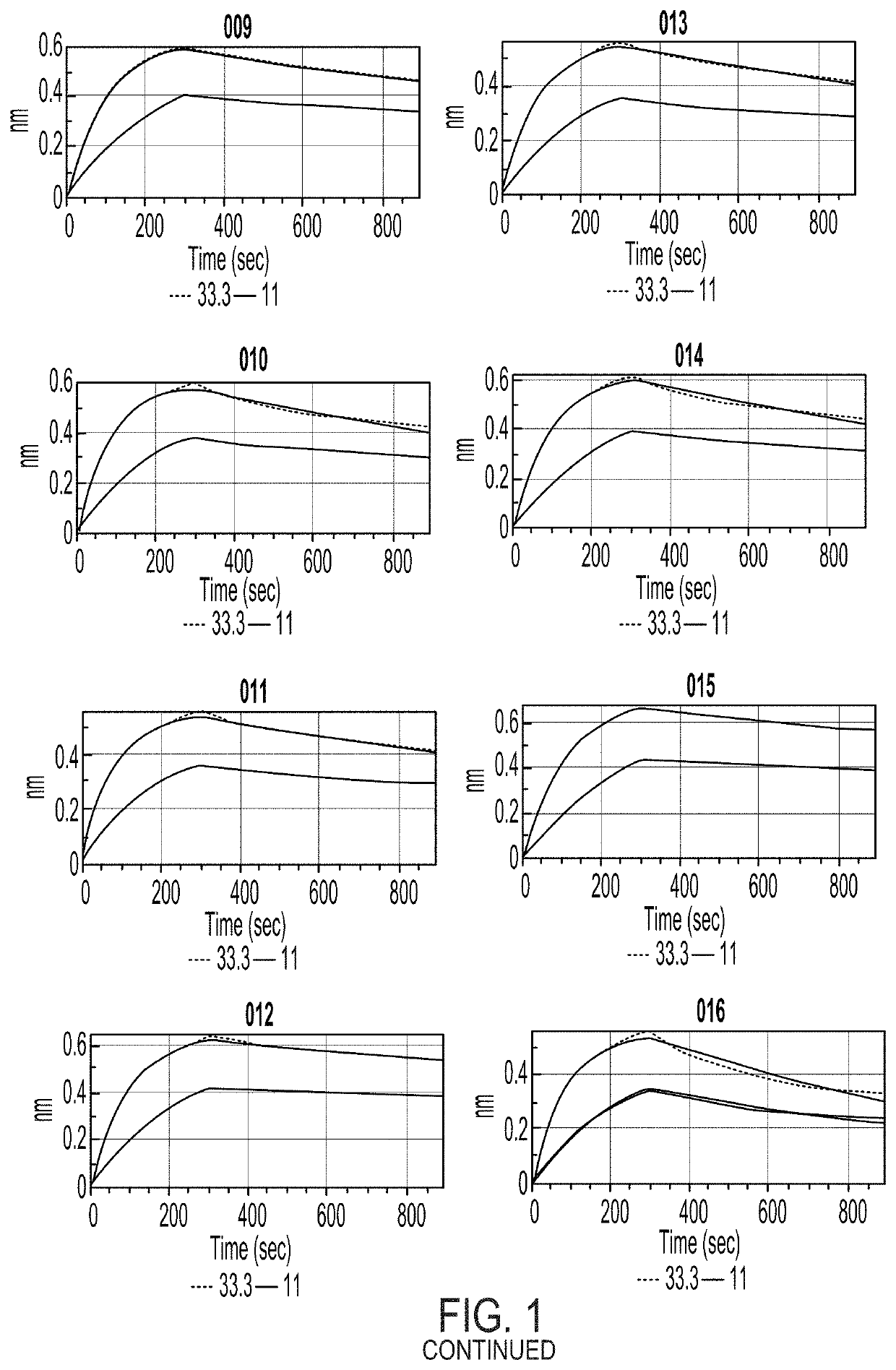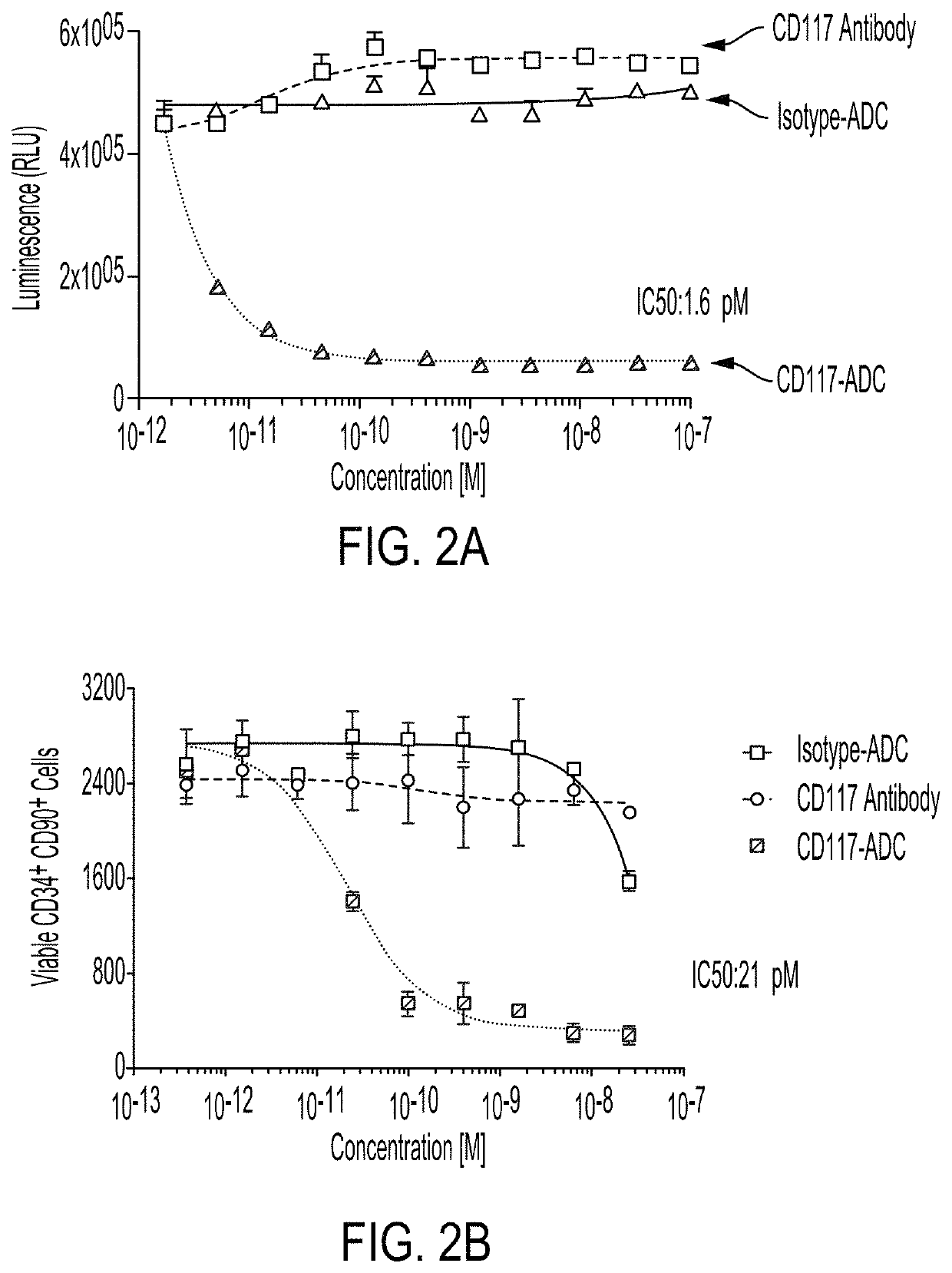Compositions and methods for the depletion of CD117+ cells
a technology of cd117+ cells and cd117, which is applied in the field of anti-cd117 antibodies and anti-cd117 drug conjugates, can solve the problems of preventing hematopoietic engraftment, affecting the use of anti-cd117 antibodies in the clinic,
- Summary
- Abstract
- Description
- Claims
- Application Information
AI Technical Summary
Benefits of technology
Problems solved by technology
Method used
Image
Examples
example 1
In Vitro Analysis of an Anti-CD117-ADC Using an In Vitro Cell Killing Assay
[0815]The anti-CD117 antibody used in the ADC in the following Example is anti-CD117 antibody CK6 conjugated to amatoxin. For in vitro killing assays using Kasumi-1 cells, Kasumi-1 cells were grown according to ATCC guidelines. More specifically, Kasumi-1 cells were cultured for three days in the presence of CD117-ADC or the controls. Cell viability was measured by Celltiter Glo. For in vitro killing assays using Human HSCs (i.e., isolated primary human CD34+ selected Bone Marrow Cells (BMCs)), human CD34+ BMCs were cultured for five days with CD117-ADC or the controls in the presence of IL-6, TPO, and FLT-3 ligand, with or without SCF. Live cell counts were determined by flow cytometry. Killing of total nucleated cells in culture mirrored the results shown in FIG. 4.
[0816]The results in FIGS. 2A and 2B indicate that CD117-ADC is highly effective at killing CD117 expressing cell lines (e.g., Kasumi-1 cells) o...
example 2
In Vivo HSC Depletion Assay Using an Anti-CD117-ADC
[0817]The anti-CD117 antibody used in the ADC in the following Example is antibody CK6 conjugated to an amatoxin. In vivo HSC depletion assays were conducted using humanized mice (purchased from Jackson Laboratories). As schematically shown in FIG. 3A, CD117-ADC (single injection of 0.3 mg / kg CD117-ADC) or controls were administered in a single dose on day 0 to the humanized NSG mice. PBMCs were collected on days 7, 14, and 21 and examined by flow cytometry. On day 21 (post injection), the presence or absence human CD34+ cells in the bone marrow was quantitated. The percent of human myeloid (FIG. 3B) or the percentage of T cells (FIG. 3C) present in the peripheral blood of CD117-ADC or control treated mice (non-CD117 binding isotype matched antibody), were determined and expressed as a percent of that cell population prior to treatment (normalized to baseline). The absolute number of CD34+ cells in the bone marrow of CD117-ADC or co...
example 3
In Vivo Tumor Study Using an Anti-CD117-ADC
[0819]The anti-CD117 antibody used in the ADC and in the naked antibody used in the following ample is CK6. The drug conjugated to the CK6 antibody in this Example is an amatoxin. 5 million Kasumi-1 cells were IV injected into naïve NSG mice. On day 7 (FIG. 4C) or on day 42 (FIG. 4D) mice were treated with CD117-ADC (0.3 mg / kg) or controls (either 0.3 mg / kg or 1.0 mg / kg for CD117-antibody group). The bone marrow of mice was analyzed for the presence of Kasumi-1 cells following euthanasia. FIG. 4A depicts the phenotypic analysis of Kasumi-1 cells in culture. FIG. 4B depicts the phenotypic analysis of Kasumi-1 cells from bone marrow of tumor bearing mice at time of euthanasia. FIG. 4C graphically depicts the survival curve of mice treated with CD117-ADC or controls. FIG. 4D graphically depicts the survival curve of mice (with a greater tumor burden than those treated in FIG. 4C) treated with CD117-ADC or controls. There were at least 5 mice i...
PUM
 Login to view more
Login to view more Abstract
Description
Claims
Application Information
 Login to view more
Login to view more - R&D Engineer
- R&D Manager
- IP Professional
- Industry Leading Data Capabilities
- Powerful AI technology
- Patent DNA Extraction
Browse by: Latest US Patents, China's latest patents, Technical Efficacy Thesaurus, Application Domain, Technology Topic.
© 2024 PatSnap. All rights reserved.Legal|Privacy policy|Modern Slavery Act Transparency Statement|Sitemap



